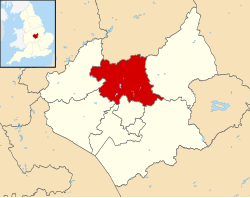History
The villages name is of Anglo-Saxon origin. In the Domesday Book of 1086, the place name was recorded as "Bebi" and derives from the Old English pre-7th Century "beo", meaning bee, plus the Old Norse "byr", a settlement or village; hence, "bee settlement". [4] [5]
In the 1870s John Marius Wilson described Beeby in the Imperial Gazetteer of England and Wales as:
- "a parish in Barrow-upon-Soar district, Leicester; on an affluent of the river Wreak, 4 miles SE of Syston r. station, and 5½ NE of Leicester. Post Town, Hungarton, under Leicester. Acres, 1,020. Real property, £2,620. Pop., 119. Houses, 26. The property is divided among a few. Beeby House is a chief residence. The living is a rectory in the diocese of Peterborough. Value, £282.* Patron, Earl Shaftesbury. The church is good." [6]
The Parish registers of Beeby commence in 1540, one of the oldest in the county. There was no mention, however, of the name Beeby in the register, as at this time you would only adopt the name 'Beeby' if you were a property or land owner. [7]
Many of the buildings in the village date back to the eighteenth and nineteenth century, mostly designed with Georgian and Victorian periods of architecture indicated by its structure materials. There is no known ancient architectural potential in Beeby, however, within the fields surrounding the conservation area there is underlying archaeological interest where there is evidence of a larger medieval settlement. According to a census report in 1801 there were 25 houses in Beeby, which has risen by only 3 in the following 200 years. [8] At present, many of the 28 buildings in Beeby are grade listed and sell between the prices of £150,000 for small cottages up to £700,000 for the Georgian and Victorian country houses. [9] The village of Beeby is referenced in Adrian Mole and the Weapons of Mass Destruction as the home of the Flowers family. [10]
Historic sites and landmarks
All Saints Church: The Anglican parish church is dedicated to All Saints and seats 100 people. [23] It stands alone looking over parkland within the village. [24] It was built with orange ironstone in the fourteenth century with the interior featuring a thirteenth century font and decorated with carvings that date throughout the churches history. [25] The tower was added to the building in the fifteenth century. [26] The church has a truncated steeple (often referred to as the 'Beeby Tub'), unfinished due to the legend of two stonemasons quarrelling and falling to their death. [27] The churches slightly raised setting ensures that it is the focal point for views from all directions across the valley.
The Manor House, Beeby: A grade II listed building dating back to the late 18th century, located on the west side of the main street. [28]
This page is based on this
Wikipedia article Text is available under the
CC BY-SA 4.0 license; additional terms may apply.
Images, videos and audio are available under their respective licenses.





